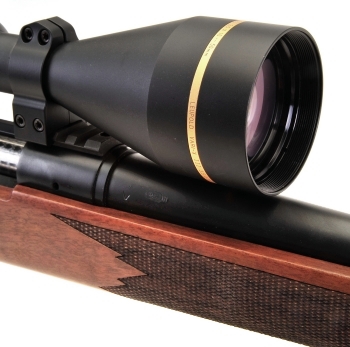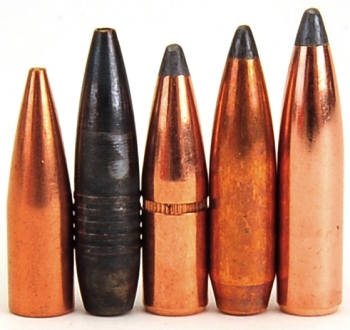
It’s very difficult to write about some rifle and cartridge combinations. There are those that take a few days to figure out – the circumstances for their use and who the manufacturer had in mind when they committed to production. Other times, answers to those questions are obvious. Then there are the tricky ones that seem obvious, but the more you work with them, the more dimensions you find.
I don’t know if Jack O’Connor made the 270 Winchester a legend or the 270 Winchester… sort of like Steven Tyler and Aerosmith, Hall and Oates … or in the more recent hundred years, Uncle Ted and guns. The point is that the 270 Winchester can’t be mentioned without bringing Jack O’Connor to mind and when you think of Jack O’Connor, the 270 Winchester is front and center.
Remington put together the right package for this cartridge. Walnut and blue tradition, 24″ barrel to give the cartridge a decent workout, but also kept fairly light to not make it a chore carrying it through the woods.
It’s a lot of gun…
 Any firearm selected for review has to have a strong personality because, as story telling skills go, I can use all of the help I can get. The traditionally styled and fastidiously finished Remington Model 700 CDL Classic Deluxe is a class act. Chamber it for the 270 Winchester and there is all the personality you’d ever want. At the lighter end of the 0.277″ bullet spectrum, the 270 Winchester can run with the 264 Winchester Magnum. At 300 yards, because of a lower coefficient of drag and higher sectional density, a 150 grain 270 Winchester bullet with an MV of 2,900 fps will be traveling 150 fps faster than a 30-06 Springfield bullet of the same bullet weight with a muzzle velocity of 3,000 fps. The 270 Winchester bullet will also hit with greater kinetic energy.
Any firearm selected for review has to have a strong personality because, as story telling skills go, I can use all of the help I can get. The traditionally styled and fastidiously finished Remington Model 700 CDL Classic Deluxe is a class act. Chamber it for the 270 Winchester and there is all the personality you’d ever want. At the lighter end of the 0.277″ bullet spectrum, the 270 Winchester can run with the 264 Winchester Magnum. At 300 yards, because of a lower coefficient of drag and higher sectional density, a 150 grain 270 Winchester bullet with an MV of 2,900 fps will be traveling 150 fps faster than a 30-06 Springfield bullet of the same bullet weight with a muzzle velocity of 3,000 fps. The 270 Winchester bullet will also hit with greater kinetic energy.

Pictured, left, the 270 Winchester and its sometimes maligned member of the 0.277″ family, the 270 WSMagnum. Ask most anyone which is the high pressure whizz bang cartridge, and they will mostly lightly say the WSM, but the rounds aren’t that far apart. CIP lists the 270 Winchester’s Pmax at 4300 BAR or 62,352 PSI and the 270 WSM Pmax as 4450 BAR, or 64,527 PSI.
Sifting through multiple and sometimes conflicting SAAMI documentation, transducer MAP listings for the 30-06 Springfield and derivative cartridges are: 30-06 Springfield (1908*) = 60,000 PSI, the 280 Remington (1957) is 60,000 PSI, the 270 Winchester (1925) is 65,000 PSI, and the 25-06 Remington (1969) is 63,000 PSI. Outside of year of introduction and anticipated firearm usage, it is difficult to determine why the variations in maximum average pressure.
The 30-06 Springfield, as a sporting rifle cartridge, was introduced in 1908 for use in a lever action rifle. The 280 Remington was introduced in autoloader and pump form before going to a bolt action. The 270 Winchester was introduced in support of the Winchester bolt action Model 54.
What would that look like coming out of a barrel?
Even a cursory look at the exterior ballistics table makes it easy to understand Jack O’Connor’s position on this cartridge. It shoots flat, hits hard, has modest recoil and it is pretty efficient. Certainly plenty of gun for elk or moose and lots of range for sheep.
| Indices | Range 0 -500 yards 150 Grain Berger VLD | ||||||||||
| Range -yds | 0 | 50 | 100 | 150 | 200 | 250 | 300 | 350 | 400 | 450 | 500 |
| Velocity – ft./sec. | 2900 | 2812 | 2726 | 2641 | 2558 | 2476 | 2396 | 2318 | 2241 | 2166 | 2092 |
| Energy – ft.-lbs. | 2801 | 2633 | 2474 | 2323 | 2179 | 2042 | 1913 | 1790 | 1673 | 1562 | 1458 |
| Path – in. | -1.5 | 1.1 | 2.6 | 3.0 | 2.1 | -0.2 | -3.8 | -9.0 | -15.8 | -24.3 | -34.6 |
| Time of flight – sec. | 0.0 | 0.1 | 0.1 | 0.2 | 0.2 | 0.3 | 0.3 | 0.4 | 0.5 | 0.5 | 0.6 |
| Best Zero Results | |||
| Near-Zero – yds. | 26 | Midrange – yds. | 139 |
| Far-Zero – yds. | 247 | Max Ordinate – in. | +3.0 |
| Point-Blank – yds. | 290 | ||
Where I think O’Connor did the round an injustice was hammering home its big game – long range potential when a 270 Winchester rifle could be just at home in woodland, particularly now when there are so many good bullet choices that will hold up on elevated impact velocity.

These are five that are often loaded and shot at Real Guns. Left to right – Hornady 110 grain HP, 110 Grain GS Custom HV, Hornady 130 Grain SP Interlock, Sierra 140 Grain Spitzer Boat Tail, Nosler 150 grain Partition.
There are many bullets available for selection with many types of construction, but these worked the best with the Remington Model 700 and for my application.
There was a need to do some juggling with powder selections. Most of the mainstream manuals have mature 270 Winchester data and, therefore, refer to older powder types. Often these were very slow powders, loaded full, but yielding well below standard load pressures.
When the dust settled, it looked like this…
Warning: Bullet selections are specific, and loads are not valid with substitutions of different bullets of the same weight. Variations in bullet material and length will alter net case capacity, pressure and velocity results. Primer selection is specific and primer types are not interchangeable. These data represents maximum loads in our firearms and test equipment and may easily be excessive in other applications. All loads should be reduced by 3%, and developed following safe handloading practices as represented in established reloading manuals produced by component manufacturers. Presentation of these loads does not constitute a solicitation for their use, nor a recommendation.
|
Cartridge: 270 Winchester |
|
| |
|
| |
|
| |
|
|
|
|
| COL and Capacity | Load Data & Performance | ||||||||
| Bullet Type | Bullet Weight |
C.O.L. Inches |
Net Grains Water |
Powder | Charge Grains |
Muzzle Velocity FPS |
Muzzle Energy Ft/Lbs |
Group Size” |
|
| Hornady HP | 110 | 3.270 | 62.3 | Re17 | 58.5 | 3465 | 2933 | 1.0 | |
| Hornady HP | 110 | 3.270 | 62.3 | Varget | 54.5 | 3363 | 2763 | 0.6 | |
| Hornady HP | 110 | 3.270 | 62.3 | H414 | 60.0 | 3434 | 2881 | 0.9 | |
| GS Custom HV | 110 | 3.240 | 60.5 | Re17 | *58.5 | 3495 | 2984 | 1.0 | |
| GS Custom HV | 110 | 3.240 | 60.5 | H414 | *60.5 | 3508 | 3007 | 0.8 | |
| GS Custom HV | 110 | 3.240 | 60.5 | RS Big Game | *58.0 | 3451 | 2910 | 1.2 | |
| Hornady SP | 130 | 3.210 | 60.2 | Re17 | 54.5 | 3192 | 2952 | 1.0 | |
| Hornady SP | 130 | 3.210 | 60.2 | H414 | 56.5 | 3205 | 2966 | 0.9 | |
| Hornady SP | 130 | 3.210 | 60.2 | IMR 4350 | 56.0 | 3131 | 2831 | 1.2 | |
| Sierra SPBT | 140 | 3.300 | 61.6 | Re19 | 58.0 | 3111 | 3009 | 0.7 | |
| Sierra SPBT | 140 | 3.300 | 61.6 | H414 | 57.0 | 3196 | 3176 | 0.9 | |
| Sierra SPBT | 140 | 3.300 | 61.6 | 7828 SSC | 60.0 | 3120 | 3027 | 1.0 | |
| Nosler Part | 150 | 3.300 | 59.5 | Re19 | 65.5 | 3002 | 3002 | 1.1 | |
| Nosler Part | 150 | 3.300 | 59.5 | H414 | 54.0 | 2994 | 2986 | 1.0 | |
| Nosler Part | 150 | 3.300 | 59.5 | 7828 SSC | 59.0 | 3060 | 3120 | 0.8 | |
| * GS Custom HV Only – Very low bore resistance | |||||||||
Shooting impressions…
The Remington Model 700 Classic Deluxe, particularly at 150 grain bullet weights, is not a pop gun. Recoil is noticeable as much as any other 30-06 Springfield class cartridge, however, the R3 Remington recoil pad absorbs most of it. The CDL is well balanced and it stays muzzle down on discharge so second shots come quickly. The Remington is easy to shoot accurately and it is certainly hunting class accurate right out of the box. Good gun, good cartridge.

Email Notification